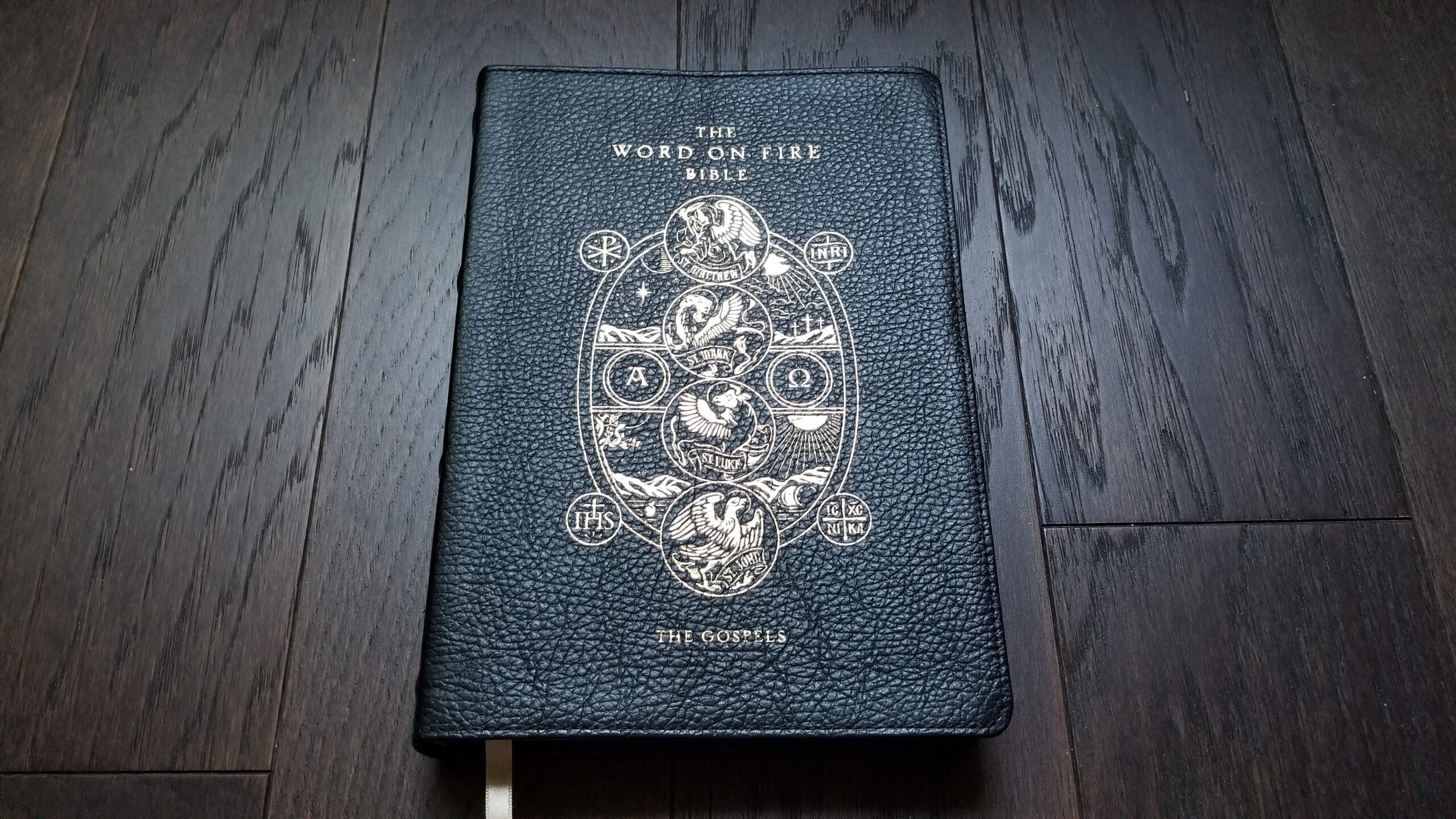
The release date for Volume 1 of the Word on Fire Bible is quickly approaching! Bishop Barron’s initial announcement generated lively discussion here and elsewhere, and several notable Catholic evangelists have featured unboxing videos on YouTube (a few notable examples are Matt Fradd, Fr. Casey Cole of Breaking in the Habit, and Bishop Barron himself).
I’m grateful to Word on Fire for providing me with an advance review copy. I’ve been quietly reading through the text over the past few weeks with the aim of providing an in-depth review based on “living in” this book for an extended period. This first part will cover the physical construction, typesetting, paper quality, etc. In the second part (which I’ll be posting on Saturday) I’ll dive into the reading experience and discuss the commentary and artistic content.
Physical Construction
The Bible will be available in three editions: paperback (list price: $29.95), hard cover (list price: $39.95), and leather (list price: $59.95). In my communications with Word on Fire, I learned that they expect to offer promotional pricing for the product launch. Currently, there is a promotional offer for 44% off an “evangelization pack” which includes one leather copy and 4 paperback copies.
I received the leather edition for review, and the leather quality is good for this price point. I would compare it with the “French Morocco” leather bindings from Cambridge University Press. It feels far more natural and substantial than the bonded leather binding on my Oxford Catholic Study Bible NABRE, and I think it’s significantly better than the genuine leather cover on the Oxford Large Print NABRE. On the other hand, this is not premium highland goatskin, so it doesn’t have the softness and supple texture of the highest-end premium bindings. I would rank it slightly below the genuine leather of the New Oxford Annotated Bible 5th edition.
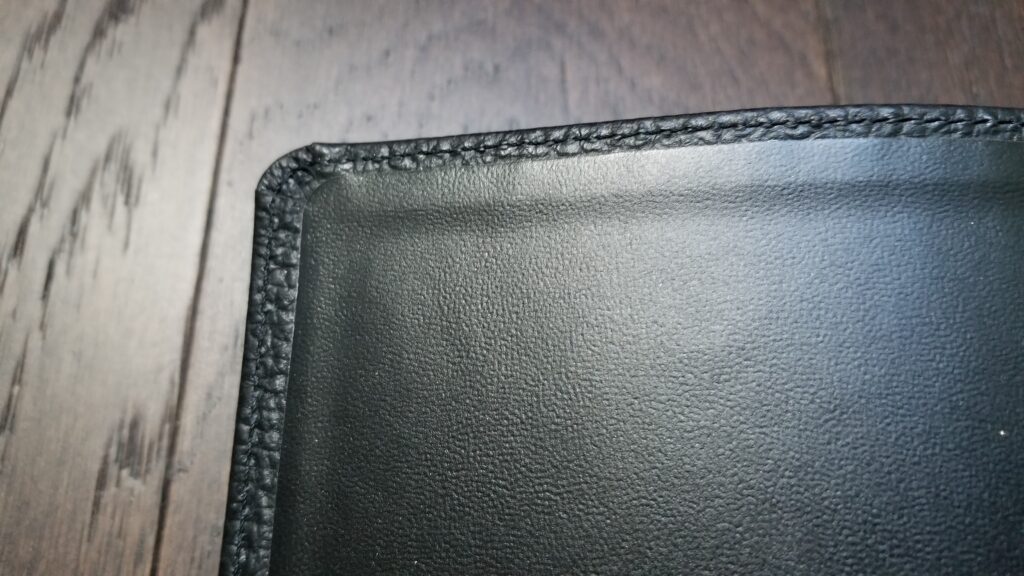
The cover is flexible, and there are raised hubs along the spine to add additional texture. As a first impression, though, this bible might feel surprisingly stiff, due to its impressively thick and opaque paper. This is nothing like tissue-thin bible paper. The paper is so much thicker than a normal bible that the whole text block feels solid and stiff. This is not a drawback at all. It speaks to the quality of this volume. Since they are not attempting to fit the entire Bible in one volume, they have been able to use much nicer paper.
The paper has a semi-glossy finish, which reflects light more than standard matte Bible paper. It’s challenging to take photos of this bible without glare obscuring some of the text, but I haven’t noticed any problems with glare while reading over the past few weeks.
The binding is sewn (the stitching is visible in the gutter of the page in the photo above), and the page edges are gold-gilded. The gilding is very high quality. This is nothing like spray-on gilding. It looks substantial, and the Bible is beautiful sitting on a table reflecting the sunlight.
As shown in the photo above, there is also a single, quarter-inch, double-sided ribbon marker.
Typesetting
The biblical text is set in a single-column format with serif font. There are generous margins on both sides of the text for note taking. All of the commentary is printed in sans-serif font. Short commentary by Bishop Barron is printed in double-column layout, while longer (multi-page) commentary sections are printed in single-column format. Excerpts from the Early Church Fathers or more recent theologians and spiritual writers are printed single-column inside color-coded boxes (tan for Early Church Fathers, and gray for other theologians and spiritual writers). The photo below shows most of these features. The biblical text is on the top left, with a short commentary section by Bishop Barron in double-column format below it. On the right-hand page, there is an excerpt from St. Jerome in the tan box at the top and an excerpt by Bishop Fulton Sheen in the gray box at the bottom.
The margins on either side of the biblical text generally measure at least 1 1/8 inches wide. Here are two photos showing the measurements for the inner and outer margins on one page:
Bishop Barron has long emphasized the importance of beauty in evangelization, and this Bible embraces that focus with its “Via Pulchritudinis” (Way of Beauty) inserts. These two-page inserts are placed throughout the biblical text with short essays on artwork that depicts relevant biblical events and themes. All of the essays are penned by Michael Stevens. The printing quality of the artwork is vivid and clear.
Due to the thickness and quality of the paper, ghosting is almost non-existent.
Size and Shape
This leather edition measures approximately 6 7/8 X 9 5/8 inches. The thickness is about 1.5 inches. During reading, I find myself alternating between keeping the Bible on my desk and holding it in my hands. The size is larger than many personal-size bibles (for example, it is certainly larger than the new Thomas Nelson NRSV-CE Personal Edition), but I don’t find it too large to hold. It’s close to the borderline, but I’ve been appreciating that the size is in a reasonable middle-ground between a reference volume that will always stay on a shelf or desk and a portable volume which would need to sacrifice other features to be small enough.
Conclusion
On the whole, this Bible is excellent for the price. Judging by the complete set of physical features (leather quality, paper quality, gilding, and binding), I think this is the highest-quality Catholic bible on the market now. Since it only includes the gospels, though, it’s difficult to make a fair comparison with other Catholic Bibles, and the price certainly becomes more daunting when considering that several additional volumes will eventually be released. Overall, I think the determining factor for whether it is worth the price will come down to the commentary and artistic features. There is a substantial amount of commentary here. I’ll delve into that in detail on Saturday!
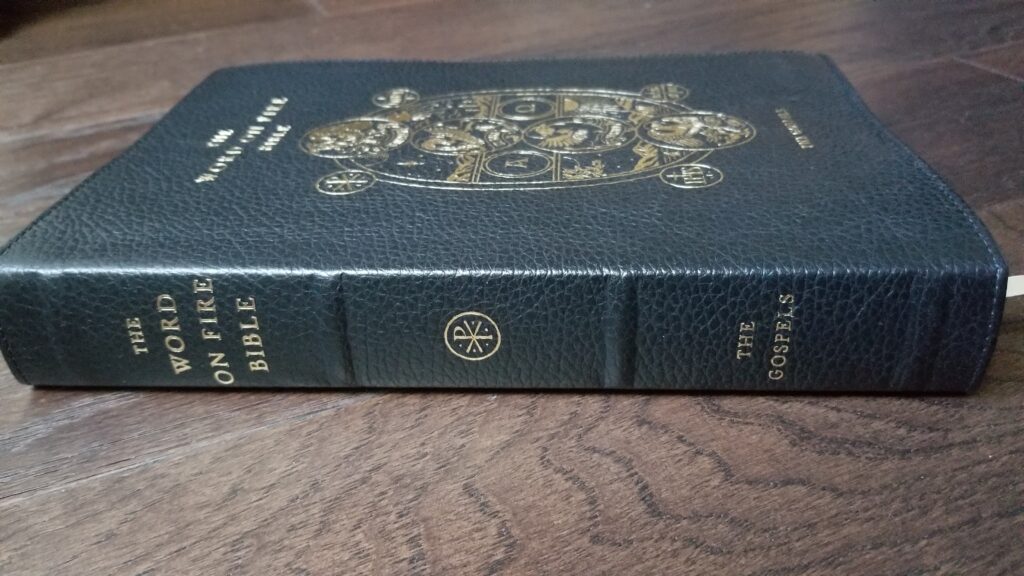
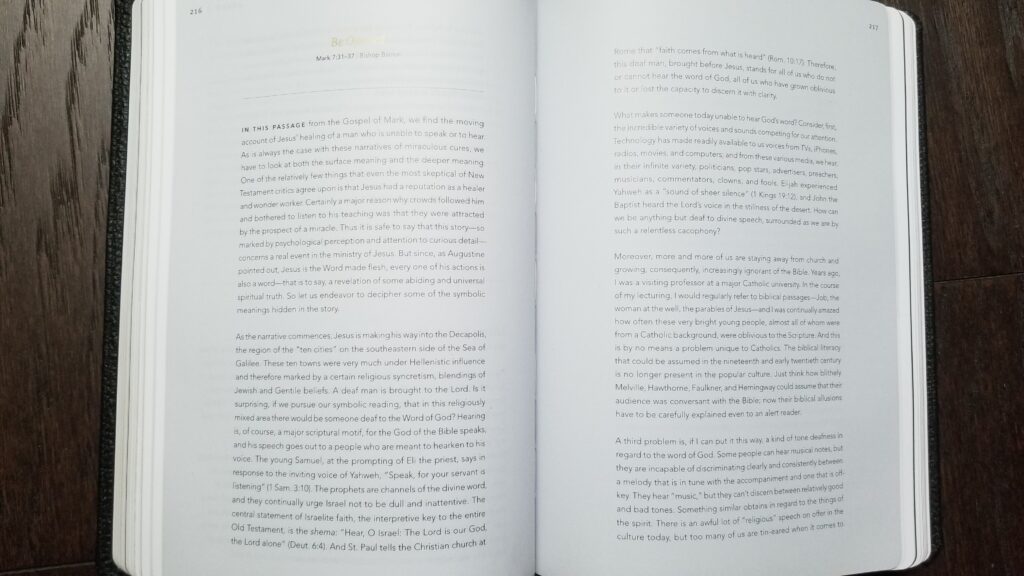
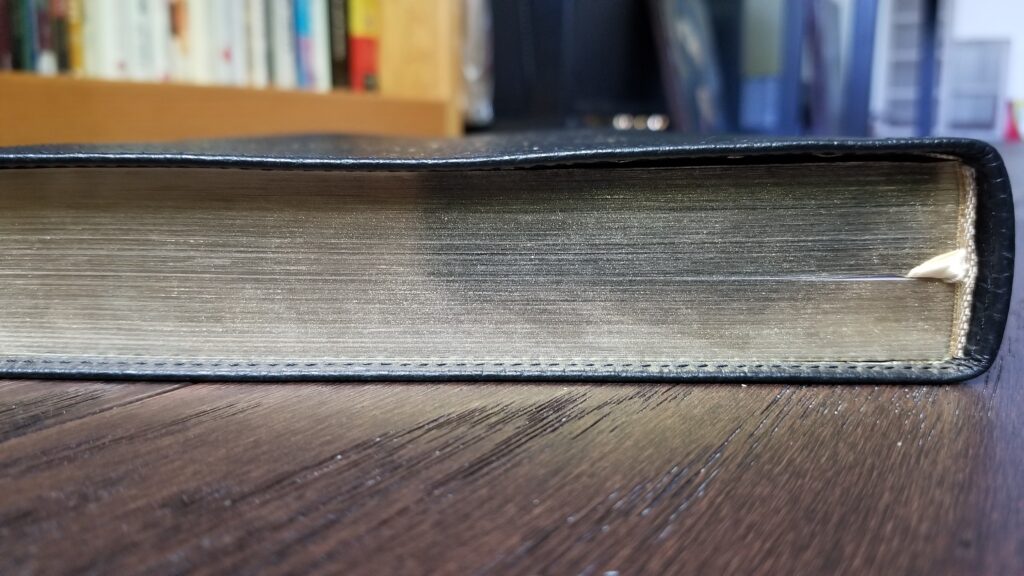
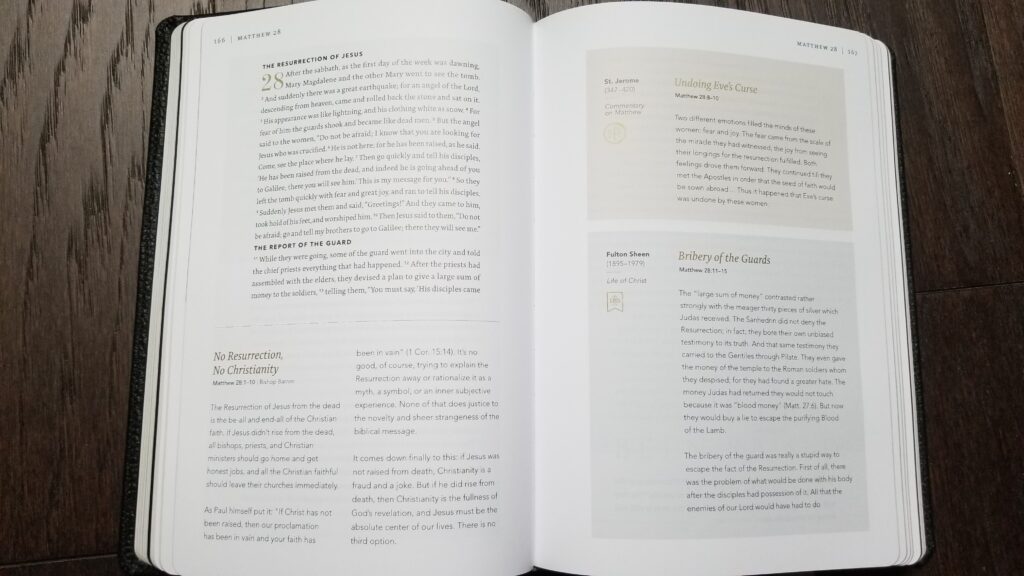
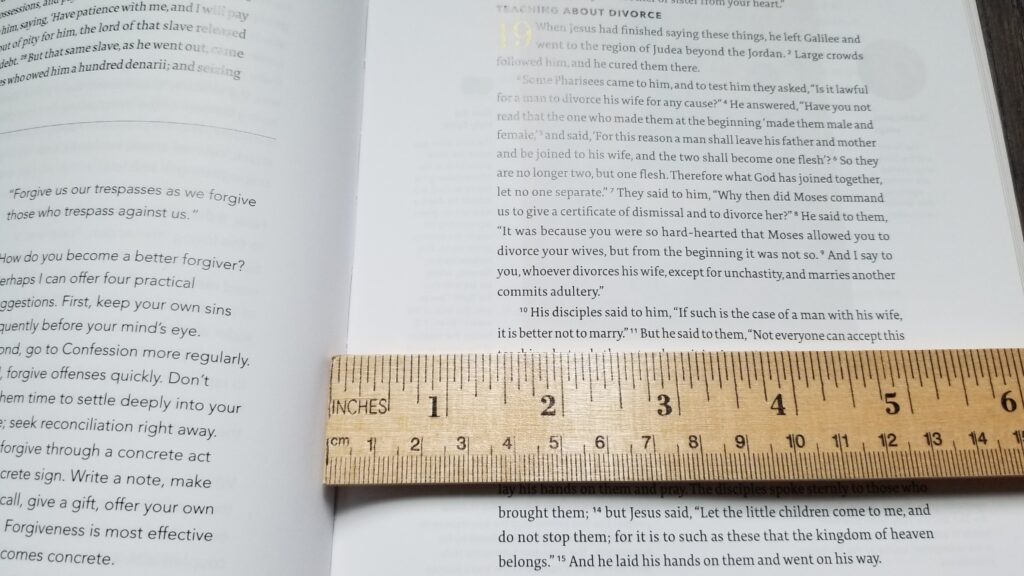
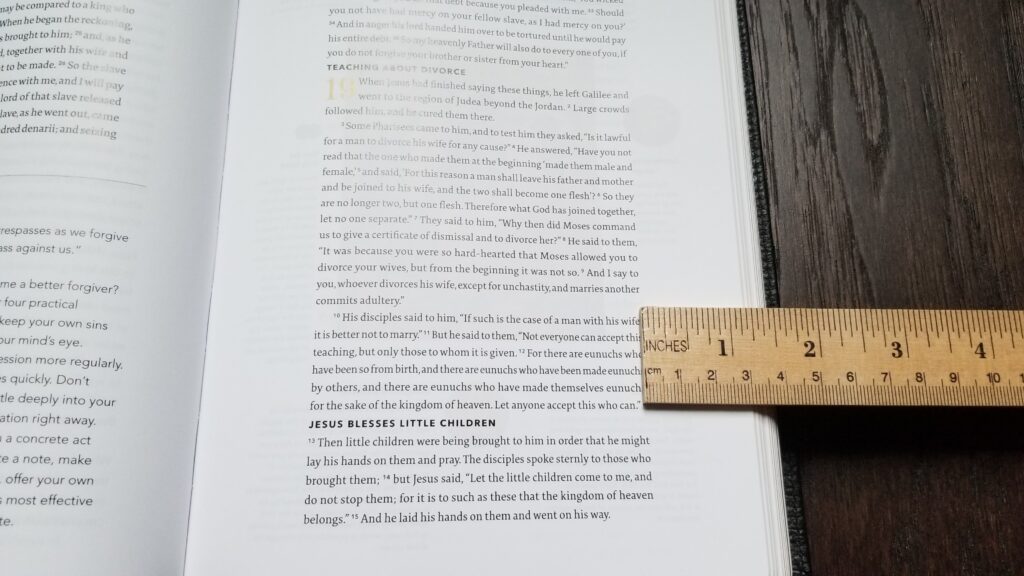
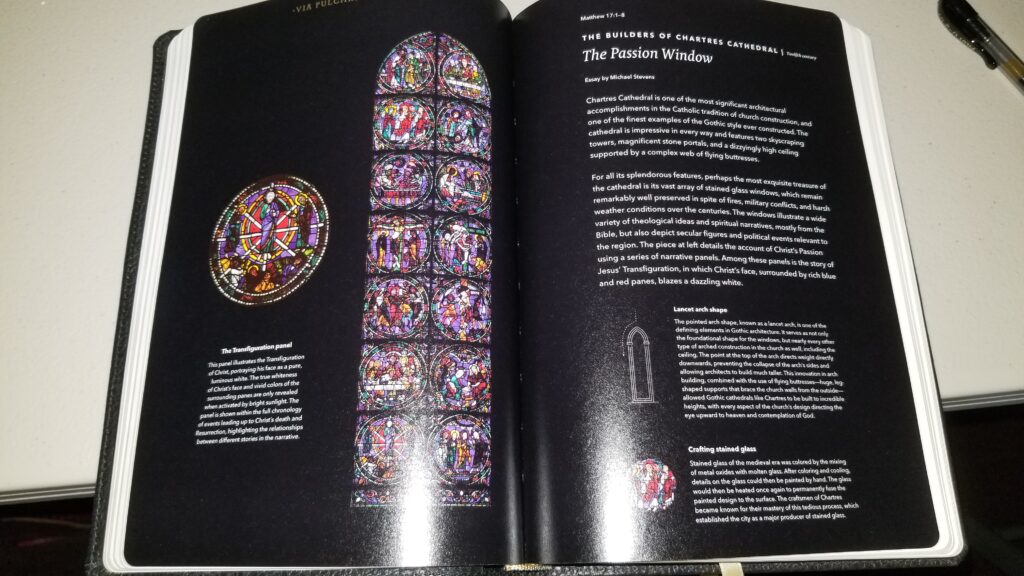
Thanks for another great review Marc! The book looks great.
I’m curious as to how the notes compare to the NCB notes, both in tone and usefulness.
As the launch date approaches (and pre-orders are being made), I presume Catholic publishers are watching this closely. It may provide a gauge by which publishers may, or may not, consider high quality Catholic Bibles in the future. The variant factor, though, is that this is a multi-volume edition. Other than the mention by Word on Fire that the second volume of the New Testament is planned for release in 2021, there is no indication as to the publication dates of the remaining volumes of the Old Testament, or how many volumes will comprise the complete Bible. Judging from other multi-volume editions (Protestant), it could be six volumes in total (an approx. cost for the complete Bible in leather would be approx. $400.00); yet Catholic multi-volumes vary: Navarre is 10 volumes, the initial english Jerusalem Bible was three volumes, and the Confraternity Edition was six volumes.
As publishers, for many decades, have been reticent about publishing high-quality Catholic Bibles (Ignatius Press has recommended the purchase of one of their Bibles, and to send it off to be rebound), this offering has factors which “run of the mill” high quality editions would not be concerned with: extensive photos, semi-gloss pages, multiple volumes, e.g. Yet, this offering, may reveal if Catholics are willing to pay a high cost, for a high quality edition, which includes only (approx.) 34% of the New Testament, and (approx.) 7% of the Bible.
This initial review by Marc is “spot on”. Thanks for the initial glimpse, on this site, to this edition. My taste shies away from glossy pages. With e-readers touting “non-glare”, it’s somewhat disheartening that to read this set of Gospels under a lamp might be quite difficult.
I wonder if this, and forthcoming leather editions, will need be stored flat, or will they “stand” being placed in a bookshelf? If not, it would make sense to make an initial investment with the hardcover edition.
I’m excited to get one, there are so many things to like about this bible. Made in Italy, smyth-sewn binding, thick white pages, single column bible text with comfortable font size and spacing, evangelistic and catechetical commentary, the art pages, and the overall attractiveness of the book and the layout.
Over the past couple of years I’ve felt tempted to get a multi-volume reader’s bible in either the ESV or CSB. But after seeing the previews for this, I think I actually like this better for a multi-volume bible. I’m leaning towards getting the hardcover so as to make it a little more cost effective to purchase 6 volumes over the ensuing years. My only hesitation is the ease with which a black cloth cover could look dusty, while the leather cover you can just wipe clean.
Marc, I don’t see any translators’ footnotes. Is this considered a reader’s edition where the footnotes have been removed? Thanks!
Good point, Ted. You’re correct. The NRSV translators’ footnotes are not included in this Bible.
GAAAAAH!
It’s.
Not.
A.
Bible.
It’s a book of Gospels.
It’s a single volume in a commentary series.
What an atrocious and transparent branding ploy.
I’m sure it’ll sell millions and end up on everyone’s nephew’s confirmation gift pile.
My retirement plan is to pull together a leather-bound volume of nothing but 400 pages of glossy dedication pages and devotional art, punctuated by occasional verses of scripture, slap an ugly foil stamp on the cover, call it a Catholic Bible and sell it for $29.95 a pop on EWTN. I’ll own my own island.
Sorry. Just really, REALLY jaded by crap Catholic Bibles and the celebrities and institutes that market them.
Do you object to the name of the “Navarre Bible,” which is actually a multi-volume commentary? How about Robert Alter’s “The Hebrew Bible” which is a three volume set of his translations and notes? Is the primary problem the branding? What if it was called “The Catholic Evangelical Bible Commentary” or “The Catholic Evangelist’s Bible” subtitled “A Multi-Volume Illuminated Bible.”
I confess that I’m still puzzled by why the branding is objectionable. Is it a reaction to Word on Fire as an organization? To me, it seems perfectly normal for a publisher or organization to name a Bible or Bible Commentary after itself. I can think of so many examples: “The New Oxford Annotated Bible,”
“The Eerdmans Commentary on the Bible,” “The Oxford Study Bible (REB),” “The Lexham English Septuagint,” “The Augustine Bible,” “The Scepter Daily Bible,” etc.
As I mentioned before, I’m mildly annoyed when publishers slap their name on a bible that they are merely reprinting (like the Augustine Bible), but I don’t feel any annoyance at all over a publisher putting their name on a Bible or commentary that includes a large quantity of original material.
Or, to use an even more extreme example, what about the Anchor Bible, which, if it is ever completed, will consist of 120 volumes? If a single volume devoted to the gospels is too much, how about three volumes dedicated just to the Gospel of John?
Also, your comment about dedication pages got me thinking: I don’t remember seeing any in this volume. I thumbed through it to double-check. This book does not have a single dedication (or registry) page of any kind. There isn’t even a “This Bible Presented to:” page.
Serious question Chris: What is the definition of “bible”? According to Webster’s:
1. “the sacred scriptures of Christians comprising the Old Testament and the New Testament”
2. “obsolete : BOOK”
Whether it’s bound together in a single book or not is immaterial then. For example “The ESV Reader’s Bible” is split into 6 volumes.
The cover on this book says “The Word on Fire Bible – The Gospels”. I take that to mean this is one volume, the gospels, of the entire WoF Bible.
But maybe there’s some other theological definition or nuance I’m missing? Seriously asking – what’s the objection here, why is this not the first volume of a multi-volume Bible?
Actually, it is. The word Bible is an English derivative from the Latin word “Biblium,” which is a second declension neuter noun meaning “book.” The plural nominative is “Biblia,” meaning “books.” Since we consider each gospel account as a ‘book,’ it is right to call it a Bible.
https://www.latin-is-simple.com/en/vocabulary/noun/3411/
Besides, why is it of concern to you? If you don’t like it, don’t buy it or talk about it. It is not like you’re going to hell for not buying the latest Catholic bible. God isn’t going to smite you down, I promise. 😉 As for us who do like Word on Fire and this Bible, we shall enjoy it, and -please God- use it as a MEANS to grow closer to Him.
CS
Chris, I couldn’t agree more. If glossy photos and celebrity commentary is the pinnacle of Catholic Bibles, what a sad state we’re in. The praise for this book (and other recent introductions, like the Augustine Institute one–which, at least, is a full Bible) speaks volumes about the terrible state of the Catholic Bible publishing industry.
If you had all the necessary publishing resources, what type of Bible would you want to produce for the Catholic Church? What features would it have?
The very first feature my dream Catholic Bible would have is all the 73 books of the Bible!
As a catechist, I simply could not recommend to my students that they purchase this book as their first “bible”. I would want them to purchase a complete Catholic Bible with all the 73 books (not a Protestant Bible — including the King James — that has only 39 Old Testament books nor this book that only contains the four Gospels.
Once all the volumes of this bible is published, I could see myself recommending it to students (I’m perfectly happy with the NRSV-CE translation and I love bibles that are filled with quality commentary), but I will not be able to recommend this edition of the Bible before then.
For myself, I’ll probably purchase either the hardcover or leather edition of this book just for the commentaries on the Gospels. Since I already own a complete NRSV-CE Bible, it’s not a big concern for my own personal use that this book contains only the four books of Gospels.
But for someone looking to purchase their very first bible, how on earth could I possibly recommend this book to them?
As an RCIA sponsor, I typically give the candidates I sponsor a copy of the Didache Bible from Midwest Theological Forum (either RSV-2CE or NABRE) and the Catechism.
https://www.theologicalforum.org/Category/124/Product/516/The_Didache_Bible_RSV2CE_Hardcover
It’s the closest thing I’ve come to a Catholic alternative to my old Oxford Annotated.
Hah, that’s an easy one to answer! It’d be a premium Bible like many of the current offerings from Schuyler, Allan, and Cambridge, to name a few. Goatskin leather, art gilt pages, four or five 3/8″ heavy silk ribbons, and a beautifully set text (single or double column would depend on the book most likely, poetry looks better in single column but double column doesn’t bother me) in a font like Williams Caslon. No commentary, no pictures, no glossy pages, no extraneous art on the cover nor trendy titles – when did simply “The Holy Bible” fall out of favor?
Not one Catholic Bible today offers this, yet many Protestant Bibles do. THAT’S what we’re missing. A fancy book like this new Word on Fire volume is nothing new or exciting, not even in the Catholic publishing world.
This, precisely. Amen.
And in brief response to various questions before:
It’s not about Word on Fire. I don’t give them much thought one way or another.
It’s not about technical definitions of what comprises a Bible.
It’s more subtle.
It’s the observation that average Catholics don’t seem to know or value the Bible enough to realize buying this isn’t getting them the full “Bible” (as a canon of Catholic scripture).
It seems to be designed to sucker buyers who only see a black leather cover, pretty stained glass on glossy pages, and the word “Bible.”
The very fact that it IS split into multiple volumes and not designed to be held, read, browsed, and prayed with looks calculating and exploitative.
Literally, looking at it gives me a similar feeling to vinyl flags over a used car lot. I just seem someone trying to sell me something I don’t need, and using the religious impulse to do it/.
Thanks for explaining in more detail, Chris. I can see much more clearly where you’re coming from now.
On the whole, I really don’t think this first volume is suckering unknowing buyers into getting less scripture than they bargained for or encouraging them to devalue the canon of Scripture as a whole. The announcements from Word on Fire have been clear that this is merely the first volume. I don’t think it does a disservice to scripture to print it in multiple volumes rather than one.
I also have a soft spot for high-quality, single-volume bibles with no notes or artwork. One of the closest candidates currently on the market is the new NRSV-CE Personal Edition from Thomas Nelson Catholic Bible Press, and it is one of my favorite Bibles. On the other hand, I’m not sure if most Catholics would be interested. In my experience, many Catholics feel intimidated by the Bible, and they often want a resource that will help them understand the Bible. A multi-volume bible with extensive homiletic commentary and artwork could make scripture more approachable for many Catholics.
Chris, I respect your opinion, sir, but I could not possibly disagree with you more. Yes, they come in volumes; necessary for the depth, richness, and beauty of this edition of Sacred Scripture with commentary. I have savored every single page of Volume I and am making my way through the others. What a marvelous spiritual experience! It’s not for everybody, I’m sure–others may prefer other editions for one reason or another. The bible itself is not a single book but a collection of books, written on more than one scroll. What’s wrong with producing a multi-volume set with beautiful color pictures by master artists and enlightening theology? I also love the St. John’s bible, the original was the first handwritten bible in over 500 years, beautifully illuminated. I pray you keep close to you whatever version of the bible you love, and in doing so, become closer and closer to Jesus. Peace be with you.
Does it “lay flat in Genesis”? 😉
Unfortunately, no. The leather seems to be reinforced near the spine. Combined with a relatively stiff text block, that results in a book that doesn’t like to lay flat. It’s possible that over time, a person could “break it in” and get it to be more compliant. As it is, I’ve been reading it for nearly 4 weeks, and it only lays flat toward the middle of the book.
For me, the quality of this Bible will be judged by the claims made by the publisher. 1) Cathedral in Print – is it beautiful, well constructed and meditative.
2) The quality of the commentary. 1:1 commentary seems generous to me (others may comment on other editions that may surpass the WOF Bible). But quantity does not necessarily equaly quality.
I will be curious to hear about the quality of the commentary, speciffically from the perspective of those engaged with catechize.
I know a few people who are connected to the Church on a more superficial level who could use a resources like this, if this Bible’s commentary lives up to its claims.
Hurry up with part 2 before the release date, please. I need to see more. $50+ for just the Gospels is a tough sell for me.
We have the Torah, alone, from the NJPS, that costs about $25-$32 (depending on where you shop).
The NJPS Psalms runs about $25 alone (we pray them over a lunar month).
The Koren Tanakh is often published in three or more volumes. ArtScroll is similar. Volumes can cost $60 or more.
I would never think that a single volume of the Hebrew Scriptures in any of these cases was not the Bible. Some of these have commentary and are designed similarly to the new Catholic version being discussed here.
I think the problem is that people get it into their heads that the only type of Bible is the one-volume Protestant type.
Sorry, but Christians did not invent the Bible. Jews did. We first had the Bible divided over a number of scrolls and later over a number of volumes, often illuminated with pictures and almost always with commentary. This latest Catholic edition is merely following in the footsteps of this most ancient tradition.
I was just now wondering how much smaller a one-volume Catholic Bible would be without titles, chapters and verse numbers, footnotes, commentaries, introductions, etc., etc.
Leather is sold out now until September.
I didn’t understand initially that this bible was only the Gospels. Having understood that now, no big deal. I already have a complete bible at home. I would suggest that most Catholics no longer attend Mass, let alone pick up a bible at home. So its dubious to me they would miss seeing the old testament or the rest of the New Testament. At least, not initially. For those (few) of us who want to understand more than Father can convey about the Sunday Gospel in a 15 minute homily, this book with commentary fills a gap. That it has wonderful illustrations from famous Masters, even better. Some of us are art illiterate. Such classic art often touches the heart or brings understanding that words sometimes cannot express fully. The price for this is not a deal breaker for most of us. One is free to stop purchasing at this volume, which doubtless covers the most important Bible books to any Christian.
“THIS IS NOT A BIBLE”
(Title: “The Word on Fire Bible: The Gospels”)
“THIS IS NOT AN ENCYCLOPEDIA!”
(Title:” Encyclopedia: A-C”)
I have to admit, this is the worst bible I have ever bought and owned. It’s very superficial and I am more for the contents. The commentaries are not helpful at all.
Grammar marm here:
June 12 question – Does it lie flat?
answer – No, it doesn’t lie flat. (insensitive verb)
Grrr.
Spell-check strikes again.
Intransitive verb